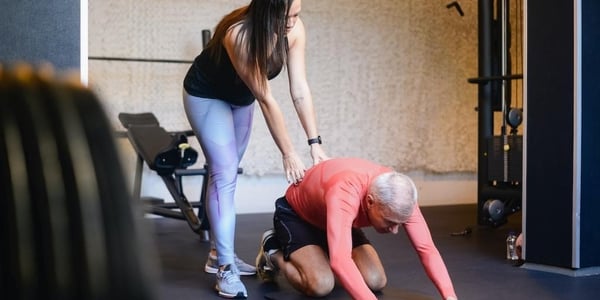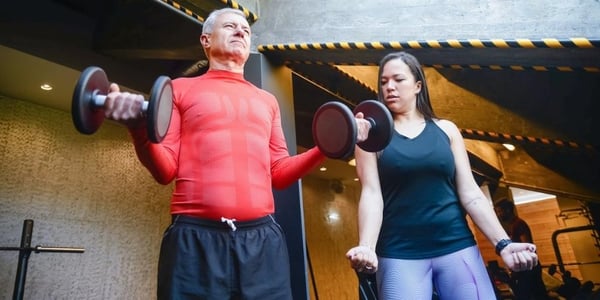It's never too late to start or restart your fitness journey. As we reach age 50 and beyond,...


It's never too late to start or restart your fitness journey. As we reach age 50 and beyond,...

Staying active and maintaining a balanced exercise routine becomes increasingly important for...

Finding the time and motivation to exercise regularly can be a challenge. The thought of committing...

Winter weather can be harsh and unforgiving. As the temperatures continue to drop, it's essential...
Exercising at Home? Stay Safe With These 10 Easy Tips
Whether it's for convenience, comfort, affordability, or safety, there are many reasons you may decide that working out at home is right for you. Exercising at home can be an excellent option as many people find that it helps them work out more often and more comfortably.
With that, while working out at home can be safer than going to the gym (more hygienic, less likely to be injured by others, fewer distractions, etc.), it presents a unique set of risks and challenges you might not have to think about as much at a gym or fitness center. So, the next time you decide to stay at home to exercise, consider the following tips for a successful workout!
Avoid Injuries While Exercising at Home
Ensure Your Exercise Space is Clear
Designate an area in your home as your workout space. Make sure your environment is clear of any hazards, obstacles, and obstructions and has sufficient room for the activity of choice.
Check the floor for kids' toys, books, weights, and anything else that could get in the way and cause you to trip and fall or hurt yourself. That goes for after the workout too. Exercises may take more room than you expect, and it's important to not have to modify your movements or otherwise put yourself at risk of having an accident while working out.
Dress Appropriately
Wear clothes that are loose and comfortable and allow you to move freely while exercising. In general, avoid any clothing that gets in the way of the activity. Just because you're at home doesn't mean you shouldn't dress for the occasion. Find performance wear that helps wick sweat from the body, doesn't chafe your skin, and doesn't restrict movements.
Drink Plenty of Water
When you're at home, staying on top of your hydration status can be challenging. While grabbing your water bottle is likely part of your exercise prep checklist when you're headed to the gym or a fitness class, it's pretty easy to forget to have water on hand while exercising at home.
When you're dehydrated, you're more tired than usual, and you have less energy. Going into an exercise dehydrated can significantly affect your performance. Make sure you're drinking plenty of water throughout the day, as well as during and after your exercise.
Shoes (When to Wear, When Not to Wear)
For all exercises, look at the surface on which you are performing the exercises, as it might not be a safe fit for shoeless training. Workouts like yoga and pilates can typically be performed without shoes.
If you sweat a lot in cardio workouts, wearing shoes may help you avoid slipping on the floor and getting injured. When your workout is packed with plyometrics or jumping moves, keeping your shoes on will minimize the impact on your feet.
Shoes will also protect your feet from objects on the floor or the weights that may slip out of your hands during your workouts.
Clean Your Exercise Equipment When Done
Even if you're working out using your home fitness equipment, you still want to wipe down your equipment after using it. This is because any equipment can easily spread germs through sweat.
Even if you are the only one who uses the equipment, you still want to maintain and clean it. Keep a disinfectant spray bottle or wipes handy along with a towel, even when exercising at home.
Practice basic hygiene such as avoiding touching your face unnecessarily, washing your hands immediately after your workouts, washing up, and changing to a new set of clothes after exercise to reduce the risk of infections.
Know Your Body
There are many free workouts available online, but everyone has different goals, priorities, and fitness levels. Listen to your body. You should not experience any pain during or after the exercise. Mild soreness over one to two days is normal, but acute bone or joint pain that does not subside with time means you are doing something wrong and should therefore discontinue the exercise.
If you have never exercised but want to kickstart a routine, good for you! Just make sure you take it slow and progress gradually. Being too ambitious and starting a workout routine that you think will push you a lot and then doing that for a few days in a row could result in overuse injuries, which will deter you from exercising eventually.
To be as safe as possible, it's a good idea to speak with a professional. Even working out from home, you can hire a trainer to provide you with personalized workout routines and answer questions about your fitness.
Cross Train
Doing just one type of exercise every day can put a strain on a particular muscle group, which can increase the probability of injury. To combat this, mix it up with different kinds of exercises so that you don't overexert certain muscles.
Check Your Form and Posture
When moving your body and lifting weights, it's always important to keep tabs on your form and posture. This is because improper workout techniques can lead to injury.
In a gym or fitness center, floor-to-ceiling mirrors make it easy to make sure you're maintaining a proper form and posture as you bend and move. At home, you probably don't have the luxury of a wall of mirrors.
It may feel uncomfortable at first, but setting up full-length mirrors in your workout space while exercising will help ensure you're doing exercises correctly and safely!
Make Time for a Warm-Up
Whether working out at the gym or at home, we're likely all guilty of not properly warming up before exercising. However, warm-ups are an important part of preparing your body for exercise, which can increase your performance and reduce your risk of injury. Plus, since you're saving time by skipping the gym commute, it should be easy to add a warm-up to your at-home exercise.
The goal of your warmup is to elevate your heart rate, which, in turn, sends signals to the rest of your body that it's time to start working. For instance, a warm-up helps redirect blood flow to your muscles, making them more pliable, and increasing your respiratory rate, ensuring your muscles get plenty of oxygen.
When it comes to a warm-up, start slow and work your way into more vigorous activity. It's helpful to incorporate some form of cardio, such as jumping jacks, as well as movements that kick-start your full range of motion, including hip openers, arm circles, and neck rolls so that the smaller movements during your actual workout are more achievable.
Have Fun
No matter what type of workout you do, it is important that you enjoy every move. You want to exercise to build healthy habits so you can keep exercising in the long-term without sustaining any injuries.
Living50+